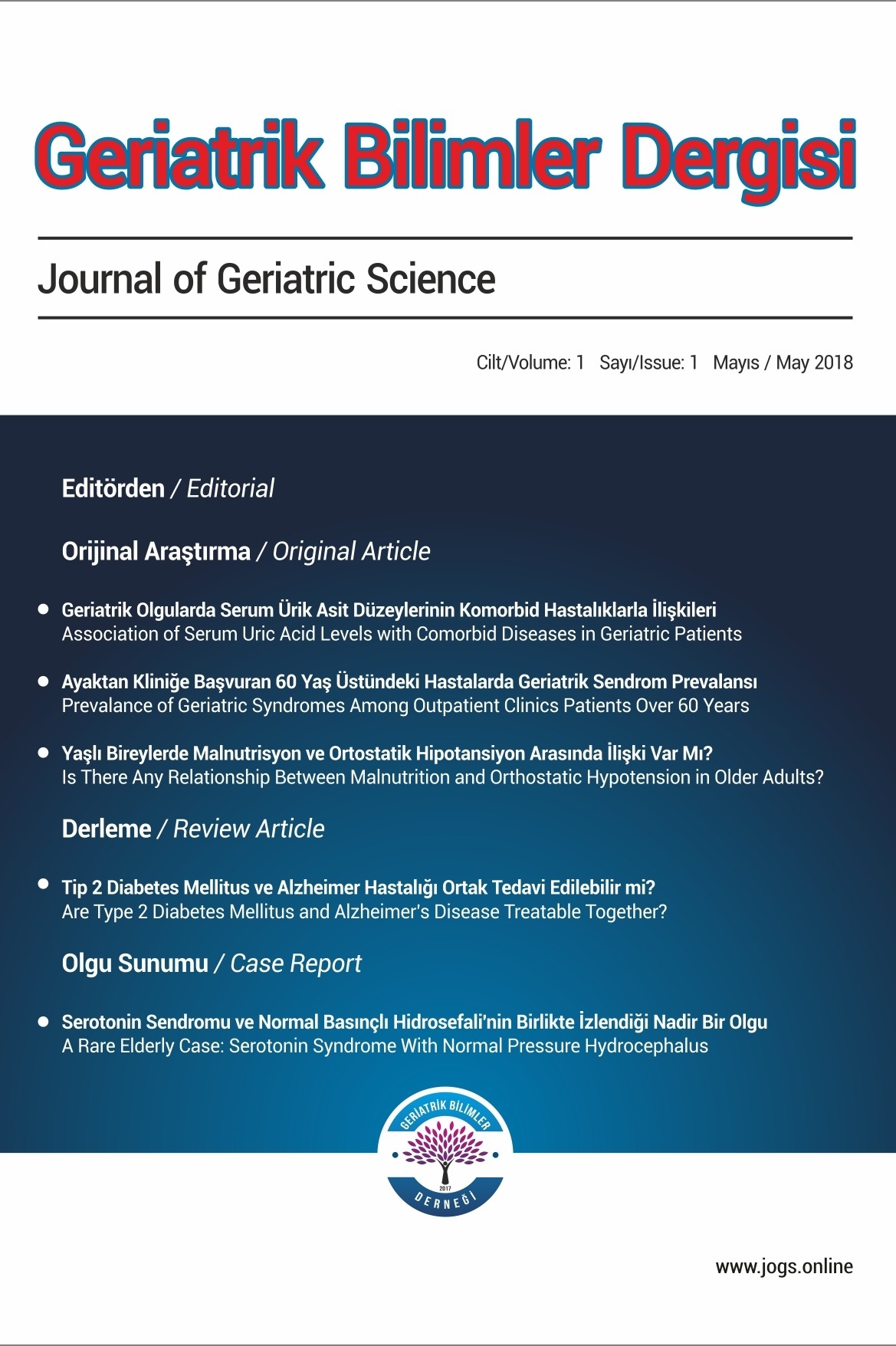Gaziantep İlinde Yaşlı Hastalarda Akılcı İlaç Kullanımı
Yaşlı, ilaç kullanımı, polifarmasi
Rational Drug Use in Geriatric Patients in the County of Gaziantep
Elderly patients Drug Utilization, Compliance rate, Polypharmacy,
___
- 1. Türkiye İstatistik Kurumu (TÜİK). Haber Bülteni, 20 Mart 2013, sayı: 13466.
- 2. Soran OZ, Feldman AM, Piña IL,et al. Cost of medical services in older patients with heart failure: those receiving enhanced monitoring using a computer-based telephonic monitoring system compared with those in usual care: the Heart Failure Home Care trial. J Card Fail. 2010;16(11):859-66
- 3. Luxembourg: Publications Office of the European Union, 2014; 34-36,56e
- 4. Kołtuniuk A, Rosińczuk J. The prevalence of risk factors for cardiovascular diseases among Polish surgical patients over 65 years. Clin Interv Aging. 2016 May 13;11:631-9
- 5. Turnheim K. When drug therapy get sold: pharmacokinetics and pharmacodynamics in the elderly. Exp Geront 2003; 38:843-853
- 6. Jacobzone S, Oxley H. Ageing and Health Care Costs. Internationale Politik und Gesellschaft Online (International Politics and Society) 1/2002 7. Mangoni AA, Jackson SH. Age-related changes in pharmacokinetics and pharmacodynamics: basic principles and practical applications. Br J Clin Pharmacol. 2004;57(1):6-14
- 8. McLachlan MS. The ageing kidney. Lancet 1978; ii: 143–5
- 9. Blechman MB, Gelb AM. Aging and gastrointestinal physiology. Clin Geriatr Med 1999; 15: 429–38
- 10. Mallet L, Spinewine A, Huang A. The challenge of managing drug interactions in elderly people. Lancet 2007;370(9582):185-91.
- 11. Leahy LG. Caution is Key When Prescribing for Older Adults. J Psychosoc Nurs Ment Health Serv. 2017;55(12):7-10.
- 12. Ferner RE, Aronson JK. Communicating information about drug safety. BMJ 2006;333: 143-145.
- 13. http://www.wales.nhs.uk/sites3/documents/439/NSF%20for%20Older%20People%20-%20Medicines%20and%20Older%20People.pdf
- 14. Qato DM, Alexander GC, et al. Use of prescriptionandover-the-counter medications and dietary supplements among older adults in the United States. JAMA; 2008; 300: 2867-2878
- 15. https://www.bu.edu/slone/files/2012/11/SloneSurveyReport2006.pdf
- 16. Heuberger RA, Caudell K. Polypharmacy and nutritional status in older adults: a cross-sectional study. Drugs Aging; 2011;28: 315-323
- 17. Beer C, Hyde Z, Almeida OP, et al. Quality use of medicines and health outcomes among a cohort of community dwelling older men: an observational study. Br J Clin Pharmacol 2011;71(4):592-9
- 18. Nobili A, Franchi C, Pasina L, et al. Drug utilization and polypharmacy in an Italian elderly population: the EPIFARM-elderly project. Pharmacoepidemiol Drug Saf 2011;20(5):488-96
- 19. Dwyer LL, Han B, Woodwell DA, et al. Polypharmacy innursing homeresidents in the United States: results of the 2004 National Nursing Home Survey. Am J GeriatrPharmacother 2010; 8: 63-72
- 20. De VriesTPGM: Guide in GoodPrescribing. Action pro-gramme onessentialdrugs. Geneva, WHO. 1994
- 21. Grahame-Smith DG. &Aronson JK: Oxford Textbook of Clinical Pharmacology and Drug Therapy. Second Edition. Oxford Universty Press 1992.
- 22. Bergendal L, Friberg A, Schaffrath A. Potential drug--drug interactions in 5,125 mostly elderly out-patients in Gothenburg, Sweden. Pharm World Sci 1995;17(5):152-7
- 23. Bjerrum L, Sogaard J, Hallas J, et al. Polypharmacy:correlations with sex, age and drug regimen. Eur. J Clin. Pharmacol 1998; 54: 197-202
- 24. Veehof LJG, Stevart RE, Meyboom-de Jong B: Adversdrug reactions polypharmacy in the elderly in general practice. Eur. J. Clin. Pharmacol 1999; 55: 533-536
- 25. Bissell P, Ward PR, Noyce PR. The dependent consumer: Reflections on accounts of the risks of non-prescription medicines. Health 2001;5(1):5–30
- 26. Raynor D, Blenkinsopp A, Knapp P, et al. A systematic review of quantitative and qualitative research on the role and effectiveness of written information available to patients about individual medicines. Health Technology Assessment 2007;11(5):1–160
- 27. Lessenger JE, Feinberg SD. Abuse of prescription and over-the-counter medications. J Am Board Fam Med 2008;21(1):45-54
- 28. Grimby C, Fastbom J, Forsell Y, et al. Musculoskeletal pain and analgesic therapy in a very old population. Arch Gerontol Geriatr 1999;29(1):29-43
- 29. Coulson NE, Terza JV, Neslusan CA, et al. Estimating the moral-hazard effect of supplemental medical insurance in the demand for prescription drugs by the elderly. Am Econ Rev 1995;85(2):122-6.
- 30. WHO. Drugs for Elderly. WhoRegional Publications, 1997.
- 31. Dolu İÇ, Bilgili N. Ankara’da Yaşayan Bir Grup Yaşlı Bireyde İlaç Kullanım Uygulamaları ve İlaç Bilgi Düzeylerinin Belirlenmesi. TAF Prev Med Bull 2009; 37-44
- 32. Alparslan GB, N. Bostan N. Huzurevi Sakinlerinin ilaç Kullanımına ve Etkileşimine ilişkin Bilgi ve Uygulamaları. Akad Geriatri 2010; 2: 99-105
- 33. Tokem YA. Karadakovan A. Yaşlı bireylere verilen bireyselleşmiş ilaç eğitim programının ilaç yönetimi üzerine etkisinin incelenmesi. Sağlık ve Toplum 2004;14:79-87
- Yayın Aralığı: Yılda 3 Sayı
- Başlangıç: 2018
- Yayıncı: Geriatrik Bilimler Derneği
Bir Üniversite Hastanesinde Hemşirelerin Yaşlılara Yönelik Tutumları
Zeynep DEMİRTAŞ, Ramazan SAĞLAN, Didem ARSLANTAŞ, Alaettin ÜNSAL
Gaziantep İlinde Yaşlı Hastalarda Akılcı İlaç Kullanımı
Necla BENLİER, Burak ŞAHİN, Muhammed Enes GÖĞER, Elif SEZAL, Dilahan SANKIR, Ayşe Kübra PAMUKİÇİ, Berfin SONGURTEKİN, Büşra DENİZ, Berkan ÜLGEY, Furkan Sinan GÜRKAN, Tanyeli GÜNAYLİGİL, Özlem SORAN
Yaşlılarda Basınç Yaralanması Risk Faktörleri
Melda BAŞER SEÇER, Nursen İlçin, Erhan SEÇER, Özge GÖBEL
